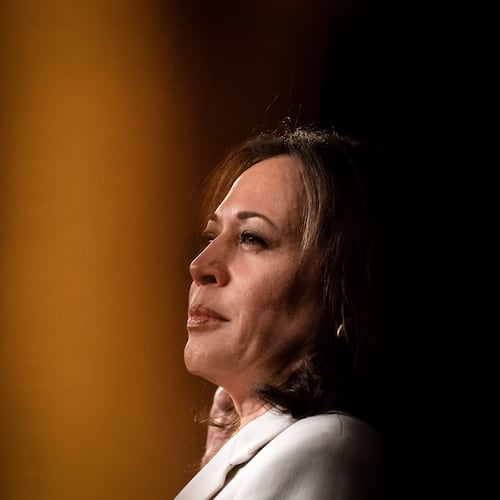A rented house in an expensive Atlanta neighborhood meant for TikTok creators that sat largely unused. A pop-up shop and “swag truck” that baffled some staffers. And then sharp cuts to TV airtime and employee benefits at a crucial moment in the campaign.
Stacey Abrams raised more than $103 million for her failed rematch this year against Gov. Brian Kemp, a record-setting haul for a Georgia gubernatorial race that allowed her to experiment with unconventional ways to promote her candidacy.
But her campaign’s expenditures have come under sharper scrutiny as new details emerge about the tight cash crunch she faced before her November defeat to Kemp by nearly 8 points.
This week, Abrams campaign manager Lauren Groh-Wargo confirmed the operation owes more than $1 million to vendors. She told Axios that a “cavalcade of negative press,” along with a steady drumbeat of polls showing her trailing Kemp, complicated fundraising efforts in the race’s final weeks.
The campaign is trying to sell its donor lists and voter contact spreadsheets to repay its debts, Groh-Wargo said. But interviews with former staffers and operatives surfaced new details about profligate spending that led to a dire financial squeeze by the end of the campaign.
Several staffers said the campaign rented a home near Piedmont Park to be a “hype house” for TikTok videos that wound up largely neglected. Some aides commandeered the vacant five-bedroom craftsman-style house, now available to rent at $12,500 a month, as a makeshift office.
A pop-up shop and “swag truck” were assigned to dispense merchandise, such as T-shirts and hoodies, to win over young voters. But staffers grumbled that there was no apparent strategy behind the giveaways, which they said seemed careless and costly.
Credit: TNS
Credit: TNS
Others vented about excessive spending on polls that were disregarded and consultants with confusing or conflicting roles within the sprawling operation.
Groh-Wargo declined to comment for this story, but she has said that Abrams had “virtually impossible” odds to win against a powerful incumbent who successfully united Republicans while also appealing to swing voters.
Abrams’ allies say she ensured that key employees made above-average salaries and paid many rank-and-file canvassers at least $15 an hour — higher than what many other candidates typically offer.
Yet other staffers and operatives, who spoke on condition of anonymity to preserve their relationship with Abrams and her allies, detailed a record of lavish spending that they say came back to haunt the campaign.
“It’s incredibly bad planning, and it shows where their values are at,” a senior Democratic official said of the spending, which will come into finer detail when financial disclosures are due in January. “You can’t look up one day and realize you can’t pay the bills.”
‘I’m done with this’
Abrams spent campaign cash at a rapid pace during her 2018 run for governor, worrying allies and emboldening her critics. She cast the strategy as the price of building a labor-intensive infrastructure designed to turn out oft-ignored voters who usually skipped midterm elections.
This cycle, she could rely upon a new financial mechanism that allowed gubernatorial nominees to raise unlimited cash from individual donors. Abrams amassed more than $53 million through that committee, helped by megadonors who wrote checks as large as $5 million.
Still, even as Abrams and her aides set midterm fundraising records, her campaign burned through cash at equally high rates.
The clearest public signal of the campaign’s teetering finances came in the final two weeks of the race, a pivotal moment when the early voting period was ramping up. Rather than step up her TV buys, Abrams’ campaign cut spending on the airwaves by more than half, to less than $1 million.
Her allies and adversaries didn’t let up. Kemp spent almost $3 million on TV ads in the final week. And Democratic U.S. Sen. Raphael Warnock reserved almost $3.5 million worth of ads for the last seven days of the midterm race.
At the time, Groh-Wargo framed the cutback as a way to shift resources toward digital outreach and on-the-ground canvassing. She has since acknowledged the decision was designed to contain expenses.
In another belt-tightening move, the campaign cut off a program in late October that allowed staffers to schedule mental health sessions. One said it was “brutal timing” for aides who had planned to schedule post-election therapy after working strenuous hours for the Democrat. Other health benefits remained intact through the end of November, officials said.
“They probably thought they could keep raising money all the way through November,” one former staffer said. “And they misplayed that badly.”
Abrams kept a low profile for a month after her defeat, playing no public role in the runoff victory that Warnock scored over Republican Herschel Walker. Days after the runoff, she scheduled several TV appearances to promote her new children’s book and tout her work to “help get Raphael elected.”
Some of her ex-deputies fumed that Abrams was embarking on a publicity tour when her campaign still owed significant debts.
“I’m done with this,” one former consultant said. “We have vendors still waiting to be paid.”
About the Author
The Latest
Featured




